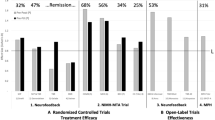This study replicated T. R. Rossiter and T. J. La Vaque (1995) with a larger sample, expanded age range, and improved statistical analysis. Thirty-one AD/HD patients who chose stimulant drug (MED) treatment were matched with 31 patients who chose a neurofeedback (EEG) treatment program. EEG patients received either office (n = 14) or home (n = 17) neurofeedback. Stimulants for MED patients were titrated using the Test of Variables of Attention (TOVA). EEG (effect size [ES] = 1.01–1.71) and MED (ES = 0.80–1.80) groups showed statistically and clinically significant improvement on TOVA measures of attention, impulse control, processing speed, and variability in attention. The EEG group demonstrated statistically and clinically significant improvement on behavioral measures (Behavior Assessment System for Children, ES = 1.16–1.78, and Brown Attention Deficit Disorder Scales, ES = 1.59). TOVA gain scores for the EEG and MED groups were not significantly different. More importantly, confidence interval and nonequivalence null hypothesis testing confirmed that the neurofeedback program produced patient outcomes equivalent to those obtained with stimulant drugs. An effectiveness research design places some limitations on the conclusions that can be drawn.
Similar content being viewed by others
References
American Psychiatric Association. (1994). Diagnostic and statistical maual of mental disorders (4th ed.). Washington, DC: Author.
Anderson, S., & Hauck, W. W. (1983). A new procedure for testing equivalence in comparative bioavailability and other clinical trials. Communications in Statistics—Theory and Methods, 12, 2663–2692.
Barkley, R. A. (1990). Attention deficit hyperactivity disorder: A handbook for diagnosis and treatment. New York: Guilford Press.
Brown, T. E. (1996). Brown Attention-Deficit Disorder Scales. San Antonio, TX: Psychological Corporation.
Clarke, G. N. (1995). Improving the transition from basic efficacy research to effectiveness studies: Methodological issues and procedures. Journal of Consulting and Clinical Psychology, 63, 718–725.
DuPaul, G. J., Barkley, R. A., & Connor, D. E. (1998). Stimulants. In R. A. Barkley (Ed.), Attention-deficit hyperactivity disorder: A handbook for diagnosis and treatment (2nd ed., pp. 263–293). New York: Guilford Press.
Firestone, P. (1982). Factors associated with children’s adherence to stimulant medication. American Journal of Orthopsychiatry, 52(3), 447–457.
Fuchs, T., Birbaumer, N., Lutzenberger, W., Gruzelier, J. H., & Kaiser, J. (2003). Neurofeedback treatment for attention-deficit/hyperactivty disorder in children: A comparison with methylphenidate. Applied Psychophysiology and Biofeedback, 28(1), 1–12.
Jacobson, N. S., & Truax, P. (1991). Clinical significance: A statistical approach to defining meaningful change in psychotherapy research. Journal of Consulting and Clinical Psychology, 59, 12–19.
Kaufman, A., & Kaufman, N. (1990). Kaufman Brief Intelligence Test. Circle Pines, MN: AGS Publishing.
Kazdin, A. E. (2003). Research design in clinical psychology (4th ed.). Boston: Allyn and Bacon.
Leark, R. A., Dupuy, T. R., Greenberg, L. M., Corman, C. L., & Kindschi, C. L. (1996). Test of Variables of Attention Professional Manual Version 7.0. Available from Universal Attention Disorders, 4281 Katella, Suite 215, Los Alamitos, CA 90720.
Lubar, J. F., & Shouse, M. N. (1976). EEG and behavioral changes in a hyperkinetic child concurrent with training of the sensorimotor rhythm (SMR): A preliminary report. Biofeedback and Self-Regulation, 3, 293–306.
Monastra, V. J., Monastra, D. M., & George, S. (2002). The effects of stimulant therapy, EEG biofeedback, and parenting style on the primary symptoms of attention-deficit/hyperactivity disorder. Applied Psychophysiology and Biofeedback, 27(4), 231–249.
Poly Software International. (2002). ProStat Version 3 (Computer software). Pearl River, NY.
Reynolds, C. R., & Kamphaus, R. W. (1992). Behavior Assessment System for Children manual. Available from American Guidance Service, 4201 Woodland Road, Circle Pines, MN 55014.
Riccio, C. A., Reynolds, C. R., & Lowe, P. A. (2001). Clinical applications of continuous performance tests: Measuring attention and impulsive responding in children and adults. New York: Wiley.
Rossiter, T. R. (1998). Patient directed neurofeedback for AD/HD. Journal of Neurotherapy, 2, 54–64.
Rossiter, T. R. (2002). Neurofeedback for AD/HD: A ratio feedback case study and tutorial. Journal of Neurotherapy, 6, 9–35.
Rossiter, T. R. (2004). The effectiveness of neurofeedback and stimulant drugs in treating AD/HD: Part I. review of methodological issues. Applied Psychophysiology and Biofeedback, 29, 95–112.
Rossiter, T. R., & La Vaque, T. J. (1995). A comparison of EEG biofeedback and psychostimulants in treating attention deficit hyperactivity disorders. Journal of Neurotherapy, 1, 48–59.
Schachter, H., Pham, B., King, J., Langford, S., & Moher, D. (2001). How efficacious and safe is short-acting methylphenidate for the treatment of attention-deficit disorder in children and adolescents? A meta-analysis. Canadian Medical Association Journal, 165, 1475–1488.
Schuirmann, D. J. (1987). A comparison of the two one-sided tests procedure and the power approach for assessing the equivalence of average bioavailability. Journal of Pharmacokinetics and Biopharmaceutics, 15, 657–680.
Stevens, J. S. (2002). Applied multivariate statistics for the social sciences (4th ed.). Mahwah, NJ: Lawrence Erlbaum.
Stevens, J. S. (1999). Intermediate statistics: A modern approach (2nd ed.). Mahwah, NJ: Lawrence Erlbaum.
Westlake, W. J. (1981). Bioequivalence testing—A need to rethink. Biometrics, 37, 591–593.
Author information
Authors and Affiliations
Corresponding author
Rights and permissions
About this article
Cite this article
Rossiter, T. The Effectiveness of Neurofeedback and Stimulant Drugs in Treating AD/HD: Part II. Replication. Appl Psychophysiol Biofeedback 29, 233–243 (2004). https://doi.org/10.1007/s10484-004-0383-4
Issue Date:
DOI: https://doi.org/10.1007/s10484-004-0383-4




